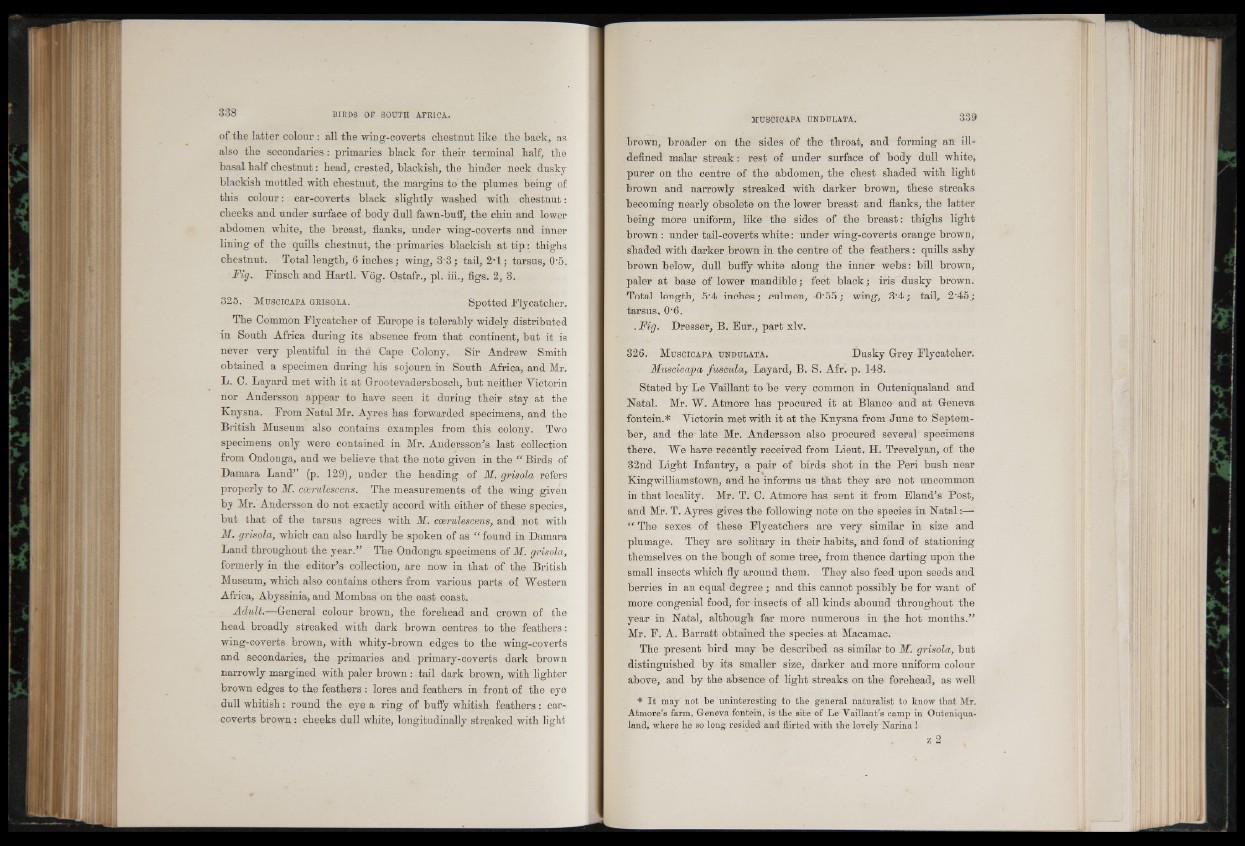
of the latter colour : all the wing-coverts chestnut like the back, as
also the secondaries: primaries black for their terminal half, the
basal half chestnut: head, crested, blackish, the hinder neck dusky
blackish mottled with chestnut, the margins to the plumes being of
this colour: ear-coverts black slightly washed with chestnut:
cheeks and under surface of body dull fawn-buff, the chin and lower
abdomen white, the breast, flanks, under wing-coverts and inner
lining of the quills chestnut, the - primaries blackish at tip: thighs
chestnut. Total length, 6 inches; wing, 3'3; tail, 2-1; tarsus, 0-5.
Fig. Finsch and Hartl. Yog. Ostafr., pi. iii., figs. 2, 3.
325. M uscicapa g r iso la . Spotted Flycatcher.
The Common Flycatcher of Europe is tolerably widely distributed
in South Africa during its "absence from that continent, but it is
never very plentiful in the Cape Colony. Sir Andrew Smith
obtained a specimen during his sojourn in South Africa, and Mr.
L. C. Layard met with it at Grootevadersbosch, but neither Yictorin
nor Andersson appear to have seen it during their stay at the
Knysna. From Natal Mr. Ayres has forwarded specimens, and the
British Museum also contains examples from this colony. Two
specimens only were contained in Mr. Andersson’s last collection
from Ondonga, and we believe that the note given in the “ Birds of
Damara Land’’ (p. 129), under the heading of M. grisola refers
properly to M. coerulescens. The measurements of the wing given
by Mr. Andersson do not exactly accord with either of these species,
but that of the tarsus agrees with M. coerulescens, and not with
M. grisola, which can also hardly be spoken of as “ found in Damara
Land throughout the year.” The Ondonga specimens of M. grisola,
formerly in the editor’s collection, are now in that of the British
Museum, which also contains others from various parts of Western
Africa, Abyssinia, and Mombas on the east coast.
Adult.—General colour brown, the forehead and crown of the
head broadly streaked with dark brown centres to the feathers:
wing-coverts brown, with whity-brown edges to the wing-coverts
and secondaries, the primaries and primary-coverts dark brown
narrowly margined with paler brown: tail dark brown, with fighter
brown edges to the feathers : lores and feathers in front of the eye
dull whitish: round the eye a ring of bufly whitish feathers: ear-
coverts brown : cheeks dull white, longitudinally streaked with light
brown, broader on the sides of the throat, and forming an ill-
defined malar streak: rest of under surface of body dull white,
purer on the centre of the abdomen, the chest shaded with fight
brown and narrowly streaked with darker brown, these streaks
becoming nearly obsolete on the lower breast and flanks, the latter
being more uniform, like the sides of the breast: thighs light
brown : under tail-coverts white: under wing-coverts orange brown,
shaded with darker brown in the centre of the feathers: quills ashy
brown below, dull bufly white along the inner webs: bill brown,
paler at base of lower mandible; feet black; iris dusky brown.
Total length, 5'4 inches; culmen, t)’55; wing, 3‘4 ; tail, 2'45 ;
tarsus, 0-6.
. Fig. Dresser, B. Eur., part xlv.
326. M uscicapa undulata. Dusky Grey Flycatcher.
Muscicapa fuscula, Layard, B. S. Afr. p. 148.
Stated by Le Vaillant to be very common in Outeniqualand and
Natal. Mr. W. Atmore has procured it at Blanco and at Geneva
fontein.* Yictorin met with it at the Knysna from June to September,
and the late Mr. Andersson also procured several specimens
there. We have recently received from Lieut. H. Trevelyan, of the
32nd Light Infantry, a pair of birds shot in the Peri bush near
King william stown, and he informs us that they are not uncommon
in that locality. Mr. T. C. Atmore has sent it from Eland’s Post,
and Mr. T. Ayres gives the following note on the species in Natal:—
“ The sexes of these Flycatchers are very similar in size and
plumage. They are solitary in their habits, and fond of stationing
themselves on the bough of some tree, from thence darting upon the
small insects which fly around them. They also feed upon seeds and
berries in an equal degree ; and this cannot possibly be for want of
more congenial food, for insects of all kinds abound throughout the
year in Natal, although far more numerous in the hot months.”
Mr. F. A. Barratt obtained the species at Macamac.
The present bird may be described as similar to M. grisola, but
distinguished by its smaller size, darker and more uniform colour
above, and by the absence of fight streaks on the forehead, as well
* I t may not be uninteresting to the general naturalist to know that Mr.
Atmore’s farm, Geneva fontein, is the site of Le Vaillant’s camp in Outeniqualand,
where he so long resided and flirted with the lovely Narina !
Z 2